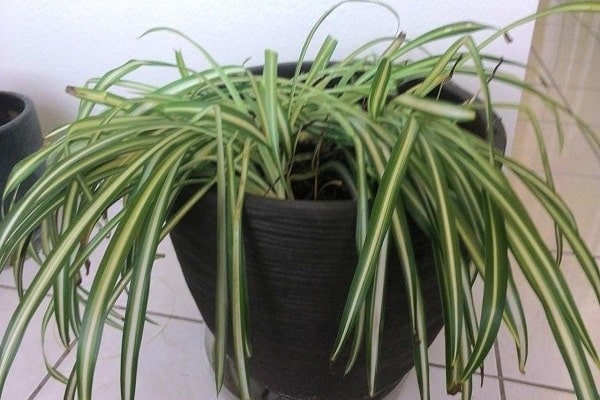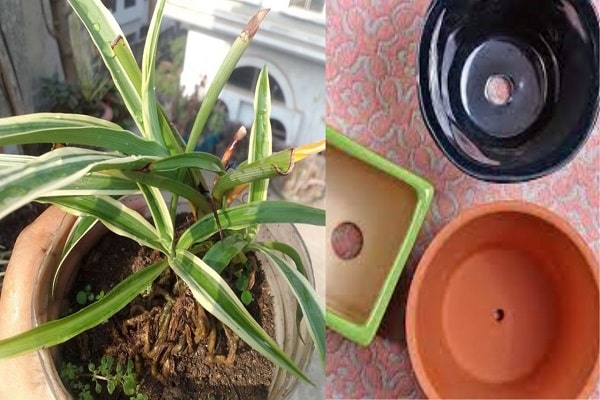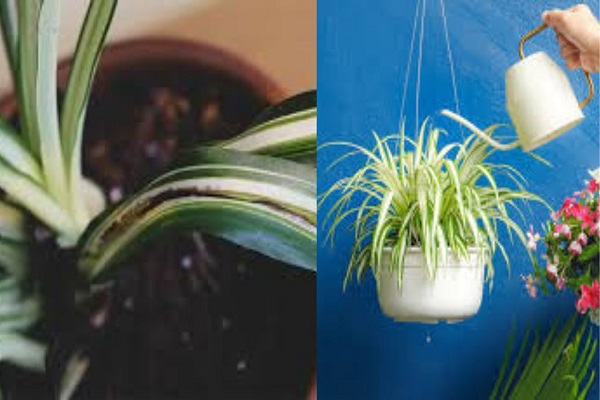Last Updated on May 1, 2023 by Md Deloar Hossain
The Spider Plant is a popular houseplant known for its easy care and ability to thrive in various conditions. But even the hardiest plants can have problems now and then. Why is my spider plant droopy Spider Plants often have trouble with drooping. There are a few things that could be causing your Spider Plant to droop.
Drooping leaves on a spider plant are usually a sign of overwatering. Spider plants are native to tropical and sub-tropical regions and thrive in humid conditions. However, too much water can cause the leaves to look droopy.
In this article, I’ll go over everything that could cause your plant to sag and the solutions that will fix and make your plant look healthy again.
Quick Navigation
The Most Common Reason For Your Spider Plant Drooping And How To Fix It
Here are three common reasons why your spider plant may be drooping and how to fix the problem:
Droop From Overwatering

If the leaves fall over and have dark brown spots on them, but the leaves aren’t crispy, it’s most likely because the plant is getting too much water. If you think your spider plant is overwatered, don’t despair—there are a few things you can do to save it.
Fix An Overwatered Spider Plant
- If you’ve been giving your plants too much water, you’ll notice that the roots are soft and dark. This means you’ve been giving them too much water.
- You might also be able to smell water sitting on the ground for a long time. This is a very unsettling smell.
- Before you water your plant, check how much water is in the soil. This ensures that you don’t water your plant until the soil in the pot has dried out.
- During the warmest months of the year, you should water your plant about once a week, but you should water it less often in the fall and winter.
- It is best to replace damp soil immediately if you suspect you overwater your plant. The alternative is to wait until the soil has dried.
- I often use a moisture meter or my finger to check how much water is in the potting mix. If it’s still wet after a few days, I didn’t water it again for a while.
Drainage Issues Can Cause Droopy Spider Plant Leaves
Spider plants can be susceptible to drainage issues. The plant’s leaves may droop or become limp when drainage problems occur. This is because the roots can’t get enough water and food, which can cause the leaves to wilt and fall off.

If you notice that your spider plant is drooping or its leaves are limp, you may need to fix a drainage problem.
Soil that is not in good shape is a common cause of drainage problems. It is best to replace damp soil immediately if you suspect you overwater your plant. The alternative is to wait until the soil has dried.
If your soil is sandy, add more organic matter and better potting soil. Also, ensure that your spider plant gets enough water by putting a layer of mulch around the roots or watering it from above.
Lack Of Water Can Cause Spider Plant Drooping

Lack of water is a common issue for plants and can cause drooping. Spider plants are especially susceptible to this because they have thin leaves that don’t hold up well when the plant doesn’t have access to enough water.
If the soil has been too dry for a long time, you may notice that the plant’s stems and leaves look like they have lost some of their strength. You can use the ways we talked about above to figure out how dry the potting mix is.
If you haven’t been watering your plant enough, give it a very small amount of water normally, you should water your spider plants about once a week. If its environment goes from one extreme to the other, you might be tempted to give it a lot of water all at once.
However, this could be bad for your Spider Plant because it changes its environment from one extreme to another. It might be a good idea to buy a moisture meter because it takes all the guesswork out of watering.
Drooping Leaves Can Indicate Overheating

If you notice your spider plant’s leaves drooping, it may be a sign that the plant is overheating. Spider plants are native to tropical regions and prefer warm, humid conditions. However, the leaves will wilt and turn brown if the temperature becomes too hot. If this happens, you’ll need to take action to cool down your spider plant.
- First, move the plant to a cooler location out of direct sunlight.
- If the air in your home is dry, provide additional humidity by misting the leaves or placing the pot on a pebble tray.
- You can also increase airflow around the plant by running a fan nearby.
- Finally, ensure you’re watering regularly and not letting the soil dry out completely.
Why is Spider Plant Dying?
Spider plants are popular houseplants, but some homeowners are reporting that their spider plants are dying. Spider plants require high humidity and water to survive, so they can die when they lose these important nutrients. There are several reasons why a spider plant might be dying:
- The plant may not have enough light. Spider plants thrive in indirect sunlight and should not be placed near a window where the sun shines directly on them. If your spider plant isn’t getting enough light, move it to a shadier spot or invest in artificial light for your plant.
- The soil may not be fertile. Use high-quality potting soil, and give your plant plenty of water daily. Before planting your spider plant, add moisture to the soil if it’s dry.
- The plant may be overgrown. Spider plants grow quickly, so they can become overgrown and stressed if you’re not careful. Prune the plant’s stems every few months to keep it healthy and flourishing.
- The plant may be infected with a virus or fungus. Remove any infected plants and treat the soil around them with a fungicide to prevent the spreading of the infection. If you’re facing a severe spider plant death, consult a garden expert for more help.
Frequently Asked Questions
Will A Spider Plant Come Back To Life?
Yes, a spider plant can come back to life if it is not too far gone. It is probably too far gone if the leaves are brown and crispy. However, you can try reviving your plant if the leaves are wilted. First, water your plant thoroughly. Then, please place it in a bright spot, out of direct sunlight. If the leaves are still wilted after a few hours, try misting them with water.
Why Is My Spider Plant Turning Brown On The Ends?
Some common causes of browning on the tips of plants are overwatering, too much fertilizer, too much water, cool weather, and incorrect light conditions. There are also genetic causes for browning. Suppose you notice browning on the tips of your plants. In that case, it is usually best to address the underlying cause before correcting the color.
Why Is My Spider Plant Floppy?
A spider plant is often floppy because it has lost its root system. Over time, the plant’s nutrient and water uptake capabilities decline, and it becomes more reliant on its leaves to absorb nutrients and water. The plant can’t hold onto soil without a strong root system and may become floppy.
Why Are My Spider Plants Leaves Turning Black?
Spider plants are a houseplant known for their easy care and ability to thrive in a wide range of conditions. However, spider plants can sometimes experience problems with their leaves turning black. There are a few possible reasons for this problem, including:
- Overwatering – Spider plants are susceptible to root rot if they are overwatered. This can cause the leaves to turn black as the plant struggles to get the moisture it needs.
- Underwatering – Spider plants also need a consistent moisture level to stay healthy. If the plant is not getting enough water, the leaves will turn black as a sign of stress.
- Soil Issues – If the soil is too dense or does not have good drainage, it can cause the roots to become waterlogged. This can lead to the leaves turning black as the plant tries to access the moisture it needs.
- Pests – Spider plants are susceptible to pests, such as spider mites, that can cause the leaves to turn black.
- Disease – A few diseases can cause the leaves of a spider plant to turn black. These include bacterial blight and fungal diseases.
If you notice the leaves of your spider plant turning black, you should try to determine the cause. This will help you take the necessary steps to correct the problem and prevent it from happening again.
Should You Cut Off Bent Spider Plant Leaves?
If you have a spider plant growing bent leaves, you may wonder if you should cut them off. The answer to this question depends on a few factors.
- First, you must consider the health of the plant. If the plant is otherwise healthy, bent leaves are not likely to be a problem. However, if the plant is unhealthy, then bent leaves could be a sign of a bigger issue. If the plant is unhealthy, it is best to consult a nursery or a plant expert to determine the best course of action.
- Second, you should also consider the aesthetic of the plant. If you are happy with the plant’s appearance, then there is no need to cut off the bent leaves. However, if the bent leaves are detracting from the plant’s appearance, you may want to consider trimming them.
- Finally, it would help if you also considered the practicality of trimming the bent leaves. If the leaves are small and easy to reach, trimming them will likely be a simple task. However, trimming leaves may be more difficult if the leaves are large or difficult to reach. In this case, you may want to consider leaving the bent leaves as they are
In Closing
If your spider plant is drooping, it could be due to several reasons. Check the sunlight and water levels, and resolve any potential problems before they worsen. Hopefully, this article has helped you out, and you can continue to enjoy your spider plant in good health!

My name is Md Robiul Islam and I’m a plant enthusiast. I like to have a garden and research different plants. I also have an interest in environmental science and would like to work in that field in the future.


